Chapter 1 Background and context
This chapter outlines the legislative requirements of the redistribution, ranging from the initial triggering of the process to the release of the proposed redistribution by the Redistribution Committee. The chapter explains how these requirements were met during the redistribution process, and also provides relevant information about the Northern Territory.
- A redistribution of electoral divisions is the process where electoral divisions and their names and boundaries are reviewed, and may be altered, to ensure, as near as practicable:
- each state and territory gains representation in the House of Representatives in proportion to their population, and
- there are a similar number of electors in each electoral division for a given state or territory
Compliance with legislative requirements
- The Commonwealth Electoral Act 1918 (the Electoral Act) specifies that a redistribution process should be undertaken when:
- the number of members of the House of Representatives to which a state or territory is entitled has changed (population change),
- the number of electors in more than one-third of the electoral divisions in a state (or one of the electoral divisions in the Australian Capital Territory or the Northern Territory) deviates from the average divisional enrolment by over ten per cent for a period of more than two months, or
- a period of seven years has elapsed since the last redistribution process was determined.1
- The procedures to be followed in conducting a redistribution process are also specified in the Electoral Act. Appendix A summarises the legislative requirements which have been followed in conducting this redistribution. Each of these requirements is discussed in further detail in this chapter.
Requirement to conduct a redistribution of electoral divisions in the Northern Territory
- Paragraph 59(2)(c) of the Electoral Act requires that a redistribution process shall commence when a period of seven years has elapsed since the last redistribution. As the last redistribution of the Northern Territory was determined on Friday 19 September 2008, a redistribution process was required to commence within 30 days of Friday 19 September 2015.2
Number of members of the House of Representatives the Northern Territory is entitled to
- On Thursday 13 November 2014, the then acting Electoral Commissioner made a determination under sub-section 48(1) of the Electoral Act of the number of members of the House of Representatives each state and territory would be entitled to at the next general election.3
- As a result of this determination, the Northern Territory's entitlement remained at two members of the House of Representatives.4
- An explanation of how the representation entitlement of the Northern Territory has been calculated is in Appendix B.
Direction for a redistribution of the Northern Territory electoral divisions
- In accordance with sub-section 59(1) of the Electoral Act, the Electoral Commission published a notice in the Commonwealth Government Notices Gazette (the Gazette) on Thursday 15 October 2015 directing that a redistribution of the Northern Territory into two electoral divisions commence.
Projection time for equality of enrolments
- Section 63A of the Electoral Act provides for the calculation of a projection time for the equality of enrolments. Determining the projection time is an important part of the redistribution process as one of the requirements of the Electoral Act is for the number of electors projected to be enrolled in a proposed electoral division at a specified point in the future, known as the 'projection time', to fall within a mandated range.
- The starting time from which the projection time is calculated, as defined by sub-section 63A(5) of the Electoral Act, is the date at which the augmented Electoral Commission for the Northern Territory (the augmented Electoral Commission) will determine the names and boundaries of electoral divisions via publication of a notice in the Gazette. The starting time for the redistribution process for the Northern Territory is Tuesday 7 February 2017 as this is the date when the augmented Electoral Commission will cause the names and boundaries of electoral divisions in the Northern Territory to be published in the Gazette.
- The Electoral Act provides for:
- the 'standard' projection time, which is the period three years and six months after the starting time, or
- an 'earlier' projection time, when the Electoral Commission is of the opinion a redistribution process will or may be required to be undertaken as a result of a change in the number of electoral divisions a state or territory is entitled to sooner than seven years after the starting time.5
- On Monday 12 October 2015, the Electoral Commission noted there was no basis for an earlier projection time and the standard projection time of three years and six months would apply. The projection time for the Northern Territory is therefore Friday 7 August 2020.
Current enrolment quota
- Section 65 of the Electoral Act requires the Electoral Commissioner, as soon as practicable after the redistribution process commences, to determine the current enrolment quota or average divisional enrolment using the following formula:

- In calculating this quota, sub-section 65(2) of the Electoral Act provides that:
- where the result is less than 0.5, the number is rounded down to the nearest whole number, or
- where the result is equal to or greater than 0.5, the number is rounded up to the nearest whole number.
- Table A shows the figures used to calculate the current enrolment quota and the resultant range of the permissible maximum and minimum number of electors in an electoral division (discussed further in the section titled 'Statutory requirements for the making of a proposed redistribution').
Table A: Current enrolment quota and permissible range for the Northern Territory
| Number of electors enrolled in the Northern Territory as at the end of the day on which the redistribution commenced (Thursday 15 October 2015) |
129 571 |
| Number of members of the House of Representatives to which the Northern Territory is entitled |
2 |
| Current enrolment quota for the Northern Territory |
64 786 |
| Permissible maximum number of electors in an electoral division (current enrolment quota + 10 per cent) |
71 264 |
| Permissible minimum number of electors in an electoral division (current enrolment quota – 10 per cent) |
58 308 |
- The Electoral Commissioner signed a written instrument on Wednesday 21 October 2015, as required by sub-section 65(1) of the Electoral Act, determining the quota of electors for the purposes of the redistribution to be 64 786.
- As part of the redistribution process, the Redistribution Committee is required to ensure that the number of electors in a proposed electoral division is not more than plus 10 per cent or less than minus 10 per cent of the current enrolment quota (see Appendix C).
Enrolment projections and projected enrolment quota
- When making a proposed redistribution, the Redistribution Committee is required by paragraph 66(3)(a) to ensure, as far as practicable, that the number of electors enrolled in the proposed electoral division at the projection time will not by more than plus 3.5 per cent or less than minus 3.5 per cent of the projected enrolment quota (see Appendix C). This quota is calculated using the following formula:

- For the purposes of this redistribution, projected enrolment has been calculated by the Australian Bureau of Statistics (ABS). The enrolment figures, together with the projected enrolment and processes used to calculate these projections, were made available on the AEC website when the invitation for interested parties to submit suggestions and comments on suggestions was made.
- Table B shows the figures used to calculate the projected enrolment quota and the resultant range of the permissible maximum and minimum number of electors in an electoral division at the projection time (discussed further in the section titled 'Statutory requirements for the making of a proposed redistribution').
Table B: Projected enrolment quota and permissible range for the Northern Territory
| Estimated total number of electors enrolled in the Northern Territory at the projection time (Friday 7 August 2020) |
141 376 |
| Number of members of the House of Representatives to which the Northern Territory is entitled |
2 |
| Projected enrolment quota for the Northern Territory |
70 688 |
| Permissible maximum number of electors in an electoral division at the projection time (projected enrolment quota + 3.5 per cent) |
73 162 |
| Permissible minimum number of electors in an electoral division at the projection time (projected enrolment quota – 3.5 per cent) |
68 214 |
Appointment of the Redistribution Committee for the Northern Territory
- Sub-section 60(1) of the Electoral Act specifies that a Redistribution Committee for the Northern Territory is required to be appointed by the Electoral Commission, via a written instrument, as soon as practicable after the commencement of the redistribution process. Section 60 also specifies the membership of the Redistribution Committee.
- The membership of the Redistribution Committee for the Northern Territory (the Redistribution Committee) is outlined in Table C.
Table C: Membership of the Redistribution Committee for the Northern Territory
| Position on Redistribution Committee |
Name |
Basis for membership |
| Chair |
Mr Tom Rogers |
Electoral Commissioner |
| Member |
Mr Mick Sherry |
Australian Electoral Officer for the Northern Territory |
| Member |
Mr Craig Sandy |
Surveyor-General of the Northern Territory |
| Member |
Ms Julie Crisp |
Northern Territory Auditor-General |
- The Redistribution Committee is responsible for:
- considering all suggestions to the redistribution and all comments on suggestions which were received by the specified lodgement times,
- developing a proposed redistribution of the Northern Territory in accordance with the requirements of the Electoral Act, and
- making the proposed redistribution, including maps showing the names and boundaries of proposed electoral divisions, and the Redistribution Committee's reasons for the proposed redistribution available for public perusal.
- The Redistribution Committee met on:
- Friday 1 April 2016
- Monday 4 April 2016
Invitation for interested parties to submit suggestions and comments on suggestions
- The Electoral Commissioner is required by sub-sections 64(1) and 64(2) of the Electoral Act to invite written suggestions relating to the redistribution of the Northern Territory and written comments on suggestions via:
- a notice published in the Gazette on a Wednesday, and
- a notice published in two newspapers circulating throughout the Northern Territory.
- The notice in the Gazette was published on Wednesday 3 February 2016. Newspaper notices were published in:
- The Atoll on Thursday 4 February 2016,6
- The Islander on Friday 5 February 2016,7
- The Northern Territory News and the Weekend Australian on Saturday 6 February 2016, and
- The Koori Mail on Wednesday 10 February 2016.8 9
- These notices included information about the steps followed in conducting a redistribution, how to participate in the process and where to find further information. Table D presents information on the options for making a suggestion or comment on a suggestion, and the extent to which these options were used.
Table D: Options to make a suggestion or comment on a suggestion
| Options |
Suggestions |
Comments on a suggestion |
| Number |
Percentage |
Number |
Percentage |
| Form upload on AEC website |
4 |
66.66% |
1 |
100.00% |
| Email |
2 |
33.33% |
0 |
0.00% |
| Mail |
0 |
0.00% |
0 |
0.00% |
| Fax |
0 |
0.00% |
0 |
0.00% |
| In person |
0 |
0.00% |
0 |
0.00% |
| Total |
6 |
100.00% |
1 |
100.00% |
- Interested parties were able to submit written suggestions from Wednesday 3 February 2016 until 6pm (ACST) on Friday 4 March 2016, the 5th Friday after publication of the Gazette notice.10 During this time, six suggestions were received by the Redistribution Committee (see Appendix D).
- As required by paragraph 64(3)(a) of the Electoral Act, copies of these suggestions were made available to the public for perusal at the office of the Australian Electoral Officer for the Northern Territory in Darwin from Monday 7 March 2016. The suggestions were also made available on the AEC website from this date.
- Interested parties were able to submit written comments on suggestions received from Monday 7 March 2016 until 6pm (ACST) on Friday 18 March 2016, the 7th Friday after publication of the Gazette notice.11 During this time, one comment on suggestions was received by the Redistribution Committee (see Appendix E).
- From Monday 21 March 2016, interested parties were able to view these comments on suggestions on the AEC website.
Redistribution Committee's consideration of suggestions and comments on suggestions
- The Redistribution Committee is required by sub-section 64(4) to consider all suggestions and comments on suggestions which were received by the required specified lodgement times.
- The Redistribution Committee found the written suggestions and comment on suggestions made to the redistribution to be a valuable contribution and is appreciative of the time and effort expended by all those who contributed.
- In formulating its proposed redistribution of the Northern Territory, the Redistribution Committee considered each of the six suggestions and one comment on suggestions. Appendix F outlines the key themes contained in these suggestions and comment on suggestions, and how the Redistribution Committee responded to them, having regard to the requirements of the Electoral Act.
Statutory requirements for the making of a proposed redistribution
- Section 66 of the Electoral Act required the Redistribution Committee to adhere to specific criteria in forming the proposed electoral divisions.
- The Redistribution Committee endeavoured to ensure that the number of electors in each proposed Northern Territory electoral division would:
- meet the requirement of sub-section 66(3) of the Electoral Act for the number of electors in a proposed electoral division to not be less than 90 per cent or more than 110 per cent of the current enrolment quota of 64 786 electors (Table A indicates the number of electors enrolled in each proposed electoral division in the Northern Territory must therefore be between 58 308 and 71 264), and
- meet the requirement of paragraph 66(3)(a) of the Electoral Act for the number of electors projected to be in a proposed electoral division to not be less than 96.5 per cent or more than 103.5 per cent of the projected enrolment quota at the projection time of Friday 7 August 2020 (Table B indicates the number of electors projected to be enrolled in each proposed electoral division in the Northern Territory at the projection time of Friday 7 August 2020 must be between 68 214 and 73 162).
- The Redistribution Committee also gave due consideration to the requirements of paragraph 66(3)(b) of the Electoral Act:
- community of interests in the proposed electoral divisions including economic, social and regional interests,
- means of communication and travel in the proposed electoral division,
- the physical features and area of the proposed electoral divisions, and
- the boundaries of existing electoral divisions, with this factor being subordinate to consideration of factors i, ii and iv.
- Further details regarding these requirements are in Appendix C.
- Appendix G outlines the mechanics of constructing proposed electoral divisions.
Population and enrolment in the Northern Territory
- The periodic redrawing of electoral boundaries is required to:
- address changes in the population of a state or territory, which may result from natural increase, natural decrease, net overseas migration or net interstate migration, and/or
- address changes in the distribution of electors in the state or territory.
The population of the Northern Territory
- On Thursday 13 November 2014, the then acting Electoral Commissioner ascertained the Northern Territory's population was 246 478.12 This represents growth of 6.26 per cent in population since the previous ascertainment of the population on Thursday 29 September 2011.
- Similarly, Figure A shows the estimated resident population of the Northern Territory has grown annually over this period.13 14 However, from Figure A it is also evident that:
- growth of the estimated resident population of the Northern Territory has slowed, and
- the estimated resident population for Australia as a whole is growing at a greater rate than is that of the Northern Territory.
Figure A: Growth of estimated resident population of the Northern Territory and Australia in the 12 months to 30 June, 2011 to 2015
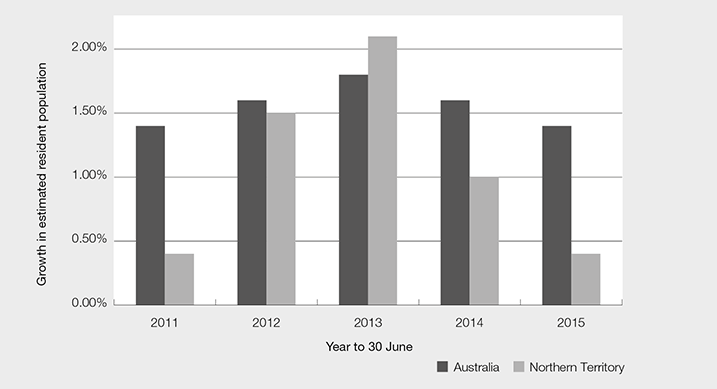
Source: 3218.0 – Regional Population Growth, Australia, 2010–11
3218.0 – Regional Population Growth, Australia, 2011–12
3218.0 – Regional Population Growth, Australia, 2012–13
3218.0 – Regional Population Growth, Australia, 2013–14
3218.0 – Regional Population Growth, Australia, 2014–15
Where is population growth in the Northern Territory located?
- At June 2015, 58 per cent of the Northern Territory's total population was located in the area of Greater Darwin.15 16 In 2014–15, Greater Darwin experienced the second fastest growth rate of all Australian capital cities. Overall, the population of the remainder of the Northern Territory decreased.17
- Figure B shows that not only is a there a significantly higher portion of residents living in the Greater Darwin area, but that much of the population growth has occurred in this part of the Northern Territory. In contrast, the estimated resident population in the rest of the Northern Territory has remained comparatively stable, but is beginning to decrease.
Figure B: Location of population in the Northern Territory, 2012 to 2015
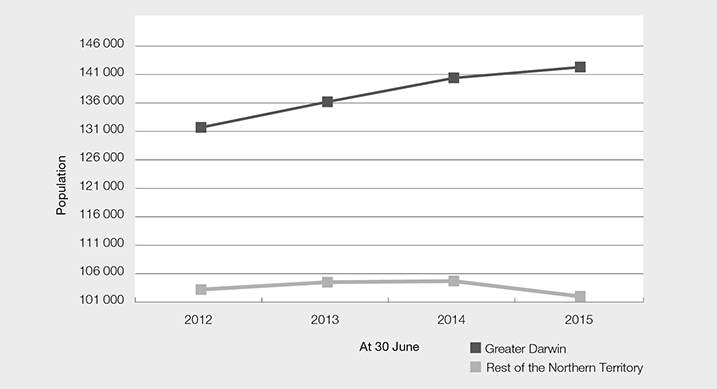
Source: 3218.0 – Regional Population Growth, Australia, 2011–12
3218.0 – Regional Population Growth, Australia, 2012–13
3218.0 – Regional Population Growth, Australia, 2013–14
3218.0 – Regional Population Growth, Australia, 2014–15
- The Northern Territory has the lowest population density of all states and territories in Australia, with a population density of 0.2 people per square kilometre (sq km). There is considerable variation within the Northern Territory. Between 2014 and 2015, the Statistical Area 2 (SA2)18 with the largest increase in population density was Darwin City which now has a population density of 170 people per sq km.19
- The ABS has observed that, in the ten years to 2015, the centre of population in the Northern Territory has moved 36 kilometres north-west to be located roughly 45 kilometres south-west of the town of Katherine. This reflects strong population growth in the Greater Darwin area.20
Enrolment in the Northern Territory
- When the redistribution of the Northern Territory commenced on Thursday 15 October 2015, 129 571 electors were enrolled to vote. By the projection time of Friday 7 August 2020, it is projected the size of the federal electoral roll for the Northern Territory would have grown by 9.11 per cent to 141 376 electors.
- Table E shows that while both current electoral divisions are expected to grow in the period from Thursday 15 October 2015 to Friday 7 August 2020, the Division of Solomon is expected to grow at a faster rate than the Division of Lingiari.21 This aligns with the trends in population growth in the Northern Territory discussed previously.
Table E: Projected growth of current electoral divisions in the Northern Territory
| Current electoral division |
Enrolment as at Thursday 15 October 2015 |
Projected enrolment as at Friday 7 August 2020 |
Percentage growth |
| Lingiari |
61 872 |
67 024 |
8.33% |
| Solomon |
67 699 |
74 352 |
9.83% |
| Total |
129 571 |
141 376 |
9.11% |
- Faster growth in the Division of Solomon is also consistent with enrolment trends in recent years. Figure C illustrates that not only are more electors enrolled in the Division of Solomon, but enrolment has grown steadily in the Division of Solomon while it has been decreasing in the Division of Lingiari.
Figure C: Enrolment in the Divisions of Lingiari and Solomon, 30 June 2012 to 31 December 2015
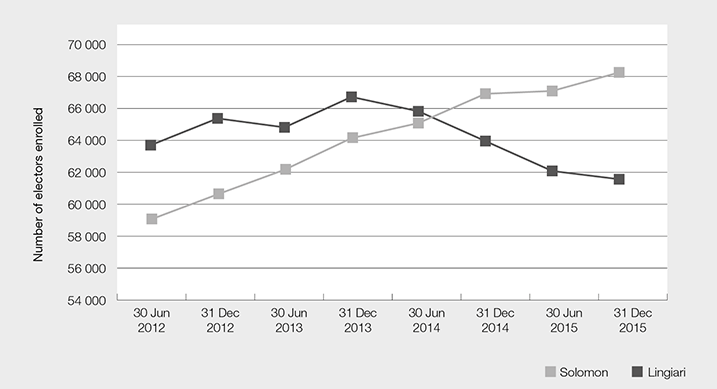
Source: Enrolment statistics available from www.aec.gov.au
- As discussed previously, in making a proposed redistribution, the Electoral Act requires the Redistribution Committee to ensure the number of electors in each proposed Northern Territory electoral division would:
- not be less than 90 per cent or more than 110 per cent of the current enrolment quota of 64 786 electors, and
- not be less than 96.5 per cent or more than 103.5 per cent of the projected enrolment quota of 70 688 electors at the projection time of Friday 7 August 2020.
- Figure D shows that, on the current boundaries, the number of electors enrolled in both the Divisions of Lingiari and Solomon meet the requirement to be not less than 90 per cent or more than 110 per cent of the current enrolment quota. However, Figure E indicates that neither electoral division meets the second requirement as:
- the Division of Lingiari, with a projected enrolment of 67 024 electors, is less than 96.5 per cent of the projected enrolment quota of 70 688 electors at the projection time of Friday 7 August 2020, and
- the Division of Solomon, with a projected enrolment of 74 352 electors, is more than 103.5 per cent of the projected enrolment quota of 70 688 electors at the projection time of Friday 7 August 2020.
- As a consequence, the Redistribution Committee was required to adjust the boundaries of both current electoral divisions to meet the requirements of the Electoral Act.
Figure D: Current Divisions of Lingiari and Solomon – enrolment as at Thursday 15 October 2015, current enrolment quota and permissible range of electors
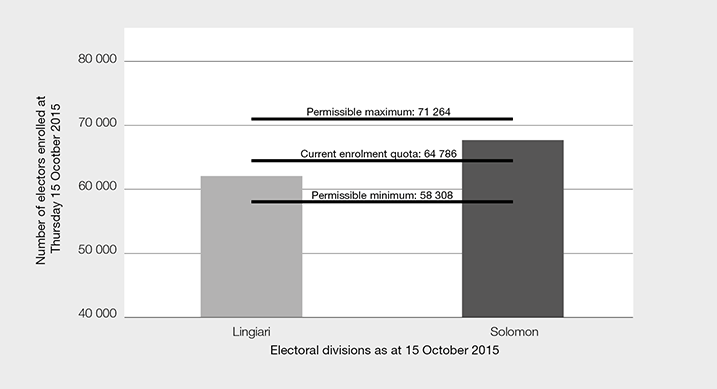
Source: Available from www.aec.gov.au/nt-redistribution
Figure E: Current Divisions of Lingiari and Solomon – projected enrolment as at Friday 7 August 2020, projected enrolment quota and permissible range of electors
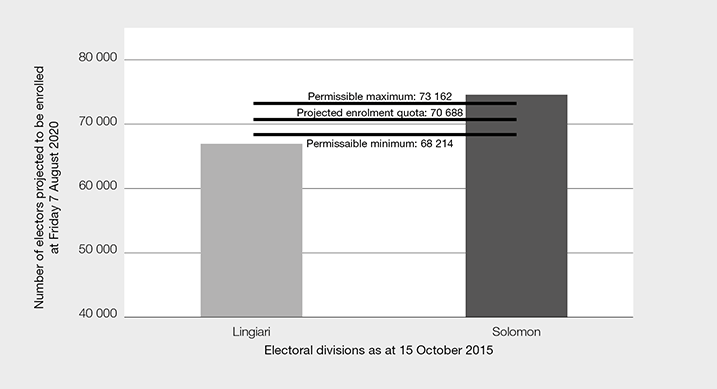
Source: Available from www.aec.gov.au/nt-redistribution








